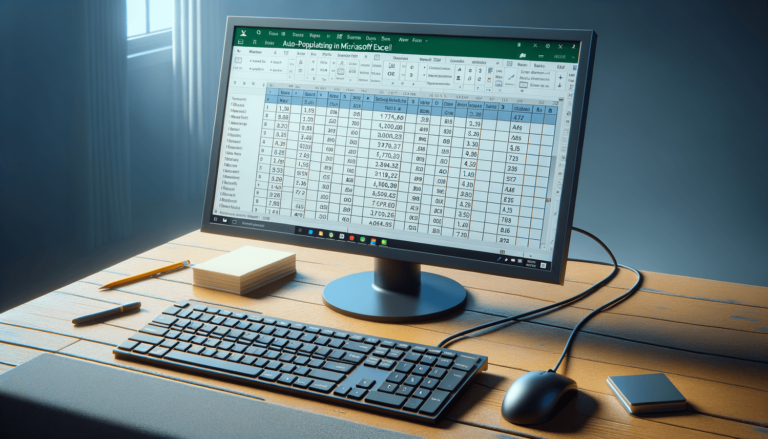

Microsoft Excel is one of the most popular tools for organizing and analyzing data. One of the most common tasks in Excel is entering dates into spreadsheets. However, manually entering dates can be time-consuming and prone to errors. Fortunately, Excel provides a simple solution to this problem through the use of data entry shortcuts and formulas that allow you to auto-populate dates.
The simplest and quickest way to auto-populate dates in Excel is by using the AutoFill feature. To use this feature, simply type in the starting date into a cell, then hover over the bottom-right corner of the cell until the cursor changes to a plus sign. Click and drag the cursor down or across to fill in a series of dates.
If you have a specific date format in mind, you can use the Flash Fill feature in Excel to auto-populate dates. Start by typing in the starting date into a cell, and then type in the next date in the series. Select the cells containing both dates and press “CTRL+E” to activate the Flash Fill feature. Excel will automatically fill in the dates in the desired series.
If you need more control over the dates you want to auto-populate, you can use the “DATE” function in Excel. This function takes three arguments: year, month, and day in that order. For example, to create a list of dates from January 1st, 2022 to January 31st, 2022, you would enter “1/1/2022” into a cell, then “1/2/2022” into the cell below it. In the next cell, type “=DATE(2022,1,3)” and press enter. Excel will fill in the next date in the series. Simply copy this formula down the column to fill in the rest of the series.
Automatically populating dates in Excel can save time and reduce the likelihood of errors. Whether using the AutoFill feature, the Flash Fill feature, or the DATE function, Excel provides a range of options to make this task simple and straightforward. Try out these methods next time you need to auto-populate dates in Excel.
If you want to add the current date to a cell in Excel, you can use the “TODAY” function. Simply enter “=TODAY()” into the desired cell, and Excel will display today’s date. If you want to format the date in a specific way, you can use the “FORMAT” function. For example, if you want to display the date in a long date format, you would enter “=FORMAT(TODAY(),”dddd, mmmm dd, yyyy”)”.
If you want Excel to automatically update the date every time you open the spreadsheet, you can use the “NOW” function. Simply enter “=NOW()” into the desired cell, and Excel will display the current date and time. If you only want to display the current date, you can use the “TODAY” function with the “CTRL+;” shortcut.
If you want to format dates in Excel, you can use the “FORMAT CELLS” feature. Simply select the cell or cells you want to format, right-click, and select “Format Cells”. From there, you can choose from a variety of date formats, or even create a custom format. You can also use the “CELLS STYLES” feature to quickly apply pre-built date formats to your cells.
Excel provides a range of options for automatically populating dates, from simple shortcuts and functions to more advanced formulas and formatting options. By taking advantage of these features, you can not only save time and reduce errors but also create professional-looking spreadsheets with ease.
Here are answers to some commonly asked questions about auto-populating dates in Excel:
Yes, you can easily create a custom date format in Excel. Select the cell or cells containing the dates, right-click and select “Format Cells”. From there, choose the “Custom” category, and enter your desired date format. For example, “dd/mm/yyyy” for a day-month-year format.
Yes, you can easily auto-populate dates for multiple years. Just use the “DATE” function in Excel and specify the year as one of the arguments. For example, “=DATE(2023,1,1)” for January 1st, 2023.
Yes, you can use the “CTRL+;” shortcut to insert the current date into a cell in Excel.
You can use the “NOW” function in Excel to display the current date and time and have it update every time the spreadsheet is opened. Simply enter “=NOW()” into the desired cell.
Yes, you can use the “Flash Fill” feature in Excel to auto-populate dates based on a specific pattern. Simply enter the first two dates in the series, select the cells containing both dates, and press “CTRL+E” to activate Flash Fill.
Explore the world of Microsoft PowerPoint with LearnPowerpoint.io, where we provide tailored tutorials and valuable tips to transform your presentation skills and clarify PowerPoint for enthusiasts and professionals alike.

Your ultimate guide to mastering Microsoft Word! Dive into our extensive collection of tutorials and tips designed to make Word simple and effective for users of all skill levels.

Boost your brand's online presence with Resultris Content Marketing Subscriptions. Enjoy high-quality, on-demand content marketing services to grow your business.
